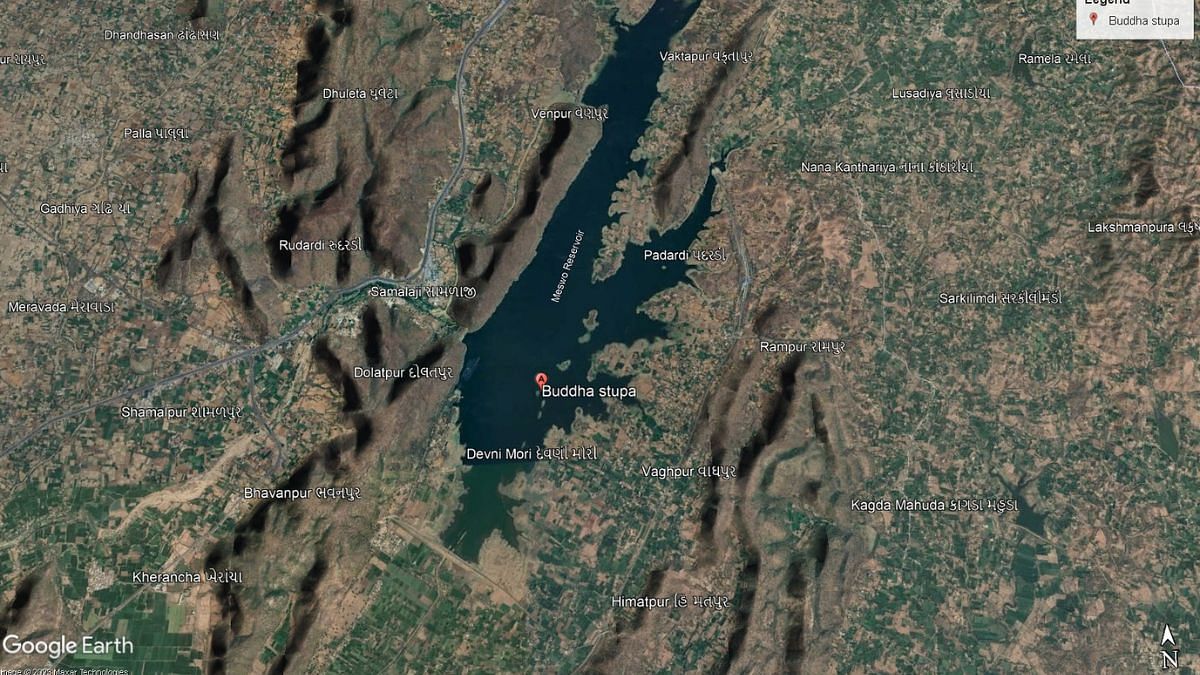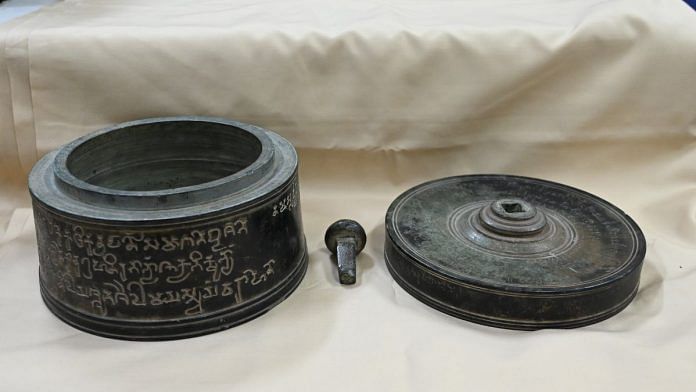Near the small town of Shamlaji in Gujarat is a reservoir that was created after the construction of the Meshvo dam in the late 1960s. Six villages were submerged, forcing residents to relocate. Today, a Buddhist flag is hoisted in the middle of this man-made reservoir, commemorating the location where holy relics were unearthed in 1962. Organic remains wrapped in silk cloth and precious artefacts were discovered in an inscribed casket from a stupa uncovered during excavations at an archaeological site in what was formerly the village of Devnimori. After deciphering the writings on the casket, archaeologists agreed that these were probably the sacred remains of Gautama Buddha.
In contrast to Nagarjunikonda in Andhra Pradesh, where archaeological relics were saved and transported, Devnimori on the western side of the country was completely submerged, leaving behind an extensive archaeological account of the digging. Aside from the sacred relics, the site provides a visual indication of (early historic) economic and cultural connections with Gandhara. The convergence of regional styles with Mathura and Gandharan schools of art—in terms of iconography, raw material and external influences—during 3rd-4th CE tells us about possible trade links or networks of interregional connections.
Today, important trade and cultural centres such as Junagadh and Vadnagar are helping Gujarat reclaim its importance in the spread of Buddhism. It is then important to consider the lost antiquity of Devnimori, which tells us not only about the cross-cultural connections but also reveals the presence of a relic casket (at the centre of the archaeological investigation) indicating the site’s significance to the Buddhist world during this period.
This puts Devnimori (and Gujarat) on par with other ancient Buddhist sites such as Sanchi, Nagarjunakonda, and Amravati.
Also Read: Buddhism has just been reduced to anti-Brahmin thought. But it shaped Hindu reforms too
Discovery of Devnimori
The archaeological heritage of drought-prone Shamlaji and its neighbouring village of Devnimori on the banks of river Meshwo was almost terra incognito until 1936 when educationist PA Inamdar led an archaeological exploration. He briefly referred to the buried monuments at Devnimori in his book Some Archaeological Finds in the Idar State. Sculptures, ceramic scatters, traces of bricks etc were noted by Inamdar. This placed the site on the archaeological map and attracted explorers like HGoetz, UP Shah and MR Majumdar.
These early explorations at Devnimori and its neighbouring sites proved fruitful when the irrigation department of Gujarat decided to build a dam in the late 1950s on the river Meshwo. The department requested the government to excavate and document the archaeological remains before the construction of the reservoir. The Department of Archaeology and Ancient History of the Maharaja Sayajirao University of Baroda was asked to excavate the site. Archaeologists RN Mehta, SN Chowdhary and B Subbharao led the project, which ran from 1960 to 1963.
The excavation commenced on 11 February 1960. In the course of three field seasons, it yielded a number of Buddhist structures including a Mahastupa (a large Sharira stupa) with relic casket, four votive or Uddesha stupas, two Buddhist monasteries (viharas) and an apsidal chaitya hall or prayer hall and a protecting wall. The Mahastupa was built by Buddhist Bhikshus Agnivarmna and Sudarshana under the guidance of Mahasena.
The excavation revealed a long-standing history of the site right from the prehistoric period (undated), with evidence of microliths (micro stone tools), to 3th–4th century CE, with major Buddhist and Hindu structures, to the 15th century CE. After the 4th century CE, the settlement that once prospered was abandoned at Devnimori and the focus was shifted to present-day towns like Shamalaji which served as the aiding village to the monasteries at Devnimori.

Around 24 Buddha images, over fifty coins of the Kshatrap period, Indo-Sassanian coins, and pottery such as Roman amphorae, polished red ware, painted ware and stamped ware were retrieved. This placed the early historic settlement in the 2nd-4th century CE.
Also Read: Did Harappans exploit animals for dairy? Lipid residue from Gujarat’s Kotada Bhadli has answers
Mahastupa and the relic casket
The excavations at the mound known as ‘Bhoja Raja No Terkro’ or the courtyard of King Bhoja began in 1960. The dig suggested this was the location of a Mahastupa—the big stupa surrounded by monasteries or viharas buried in the adjoining fields. The stupa was 37 feet high with a base rammed with pebbles, brickbats, kankar and yellow silt. Platforms one and two had decorative mouldings and floral motifs on them.
The excavators took a vertical trench at the centre of the stupa and excavated it layer by layer. After reaching the lowest levels of the stupa the excavators found a casket made of green schist. This was a casket with inscriptions on the body and lid. Inside the stone casket was a copper box which contained the sacred relics of Buddha. The inscription on the casket mentions Buddha as ‘Dashaballa’. Below the casket, a pot containing eight silver coins was retrieved. The last ruler of the period of this hoard was Vishvasena, whose rule ended after 305 BCE.
Archaeological evidence from the stratigraphy also points to the fact that this stupa had been repaired several times before its eventual abandonment. As for the materials used in the various structures in the settlement, it was predominantly bricks and stones.
The inscription on the body of the casket is in Sanskrit language and Brahmi script whereas the inscription on the lid is in Prakrit language and Brahmi script. One of the inscriptions clearly states that this Mahastupa was built in year 127 of the Kathika rulers’ reckoning, during the reign of Rudrasena (under the Kardamaka line of the western Kshatrapa), for the prosperity of Dharma and the Sangha in north Gujarat in 400 CE. Naturally the archaeologists assumed that the king Rudrasena mentioned in this inscription is the Rudrasena of the Kshatrapa dynasty. However, recently few epigraphists and scholars, like Sushmita Sen Pramanik who is the custodian of these relics at Department of Archaeology and Ancient History, MSU Baroda, argue that the Rudrasena mentioned in this inscription is a local ruler, pushing the casket to a later date.
Talking of external influence at Devnimori, the shape of this casket is similar to those found in the Gaz Dheri site. The method of inscription follows the style of the Shinkot steatite casket inscription of the time of Meanander—c.175-09 BCE. The shape, as well as the style of inscribing, indicates that the methods adopted at Devnimori were better known in Gandhara region and that the close similarity of these features is an indication of the continuity of this tradition in western India.
External influence
Around 26 Buddha images with the Dhyana mudra and in padmasana, both fragmentary and preserved, have been found in the stupa. The stylistic attributes have been ascribed to the Gandharan school of art based on features of the face, hairstyle, drapery, and seat. Some images are also carved out of red sandstone and bear a resemblance to the artistic trend that persisted in Western India at that time.
The form of the stupas also followed the pattern that was known at the sites like Mathura, Nandangarh, and Ghantasila. Its form is not highly elongated and seems to differ considerably from those known from the Punjab, Singh and Gandhara regions.
Its decorative motifs—the acanthus, the laurel and the olive—could be traced to the Gandhara school. The stilted arches and the broad arches are highly characteristic forms that are seen in the Gandhara region. Medallions and even the grotesque faces have Western influence. The latter is the Indianised version of Medusa. The structures, antiquities, coins, bricks, and stone objects found point to the regional exploitation of local resources and import of certain raw materials by the inhabitants of this Buddhist settlement.
Excavations also indicate a gradual growth of the religious significance and development of settlement on the site with the stupas succeeding the viharas. With vast occupation phases starting from the microlithic period to the early medieval, the settlement at Devnimori shows a synthesis of various art styles as seen from the relics of the Buddha.
Also Read: Shaivite rivals were not Vaishnavites, but tantric Buddhists in medieval era
Lost heritage
The edicts at Junagadh and freshly excavated monasteries and stupas at Vadnagar, along with the lost site of Devnimori narrate the story of the spread of Buddhism in Gujarat. All these sites placed strategically on the trade route connecting western India to the northwestern half of the subcontinent facilitated the spread of Buddhist doctrines.
Moreover, the discovery of sacred relics at Devnimori suggests that it was not only an important Buddhist site but a sacred one. With only a few sacred relics discovered in South Asia, the findings at Devnimori make it part of the popular lore of 80,000 relic stupas. Holding such cultural and religious significance, it is unfortunate to see Devnimori submerged and lost today at the cost of development.
Disha Ahluwalia is an archaeologist and junior research fellow at the Indian Council Of Historical Research. She tweets @ahluwaliadisha. Views are personal.
(Edited by Theres Sudeep)



